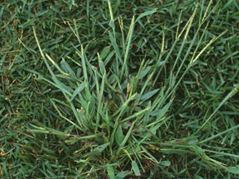 Broad-leaf Weed & Crabgrass Controls: Proper timing and application procedure is necessary for most effective results. Crabgrass and Broadleaf weeds are not treated in the same manner.
Broad-leaf Weed & Crabgrass Controls: Proper timing and application procedure is necessary for most effective results. Crabgrass and Broadleaf weeds are not treated in the same manner.
Crabgrass results from over-wintering seeds that germinate when soil temperature starts to warm in the Spring. The most accurate indicator of when crabgrass seeds will start germinating is when the forsythia bush starts flowering. At that time, an application of Crabgrass Preventer will prevent most seeds from germinating. If you plan to put down grass seed, choose the type of Crabgrass Preventer that will allow the grass seed to germinate while preventing the crabgrass seed from germinating. Protection is provided for 10-12 weeks, so be careful not to apply too soon, or too late. It might be necessary to reapply a Crabgrass Prevented in mid June if your lawn has not thickened to cover the bare spots. Do not rake the treated areas, as that disturbance will reduce effectiveness.
 Broadleaf Weeds are a result of the plant roots over-wintering and producing leaves the following Spring. These weeds cannot be prevented from emerging from the ground. It is necessary to wait until they produce leaves and then apply a Weed Killer to the leaf surface. For those weeds that produce a seed stalk, such as dandelions, it is important to treat them before seed production starts. If you choose a powdered or granular weed killer, moisten the leaf surface of the weed before applying, thus allowing the powder to stick to the leaf surface. Allow the leaf surface 12-24 hours to absorb the Weed Killer without being washed off by rain or sprinkler water. We recommend using a Crabgrass Preventer or Weed Killer without fertilizer included in the bag. It is often necessary to apply both a Crabgrass Preventer and a Weed Killer within one week of each other and a double application of fertilizer is detrimental to the lawn. For best fertilizer results, consult our Lawn care Calendar
Broadleaf Weeds are a result of the plant roots over-wintering and producing leaves the following Spring. These weeds cannot be prevented from emerging from the ground. It is necessary to wait until they produce leaves and then apply a Weed Killer to the leaf surface. For those weeds that produce a seed stalk, such as dandelions, it is important to treat them before seed production starts. If you choose a powdered or granular weed killer, moisten the leaf surface of the weed before applying, thus allowing the powder to stick to the leaf surface. Allow the leaf surface 12-24 hours to absorb the Weed Killer without being washed off by rain or sprinkler water. We recommend using a Crabgrass Preventer or Weed Killer without fertilizer included in the bag. It is often necessary to apply both a Crabgrass Preventer and a Weed Killer within one week of each other and a double application of fertilizer is detrimental to the lawn. For best fertilizer results, consult our Lawn care Calendar

